 |
 |
 |
| |
Exercise Reduced Comorbidities Risk A Lot / "the detrimental consequences of inactivity are exacerbated by excess visceral adiposity" - Physical Activity Consistently Linked to Comorbidity in US HIV Group
|
| |
| |
.....from Jules: The NIH & ACTG leadership refuse to do exercise studies in HIV+. With the aging generation upon us & the numbers & percentages with HIV who are over 65 expected to be 50% soon nationally, but already 50% in NY & SF, we need special services & a national discussion about Aging & HIV. Among the services needed is an exercise & diet project for patients and Aging Clinics placed with large HIV clinics. Advocates & these federal officials as well as the White House are avoiding addressing aging issues. There is research ongoing to try to find medical interventions like anti-inflammatory medications but that is not the issue, the issue is to have a national discussion to identify key issues, gaps, and develop a strategy. All too often patients fall through the cracks, that is, comorbidities go unaddressed. Many older aging patients are experiencing falls & fractures due to frailty, gait problems, and cognitive impairment, this will lead to earlier & higher death rates - we can discuss & find ways to address these concerns. The politics of HIV is killing these patients. Only cure & prevention get attention with federal officials due to the politics of HIV.
2/3 had low/very low physical activity - in HIV+ with lots of belly fat & lipoatrophy - Among those with DXA scans, 94% had excess total body fat (that is, >30%), 33% excess visceral adipose tissue, and 14% lipoatrophy. An interactive effect of self-reported PA and adiposity was observed, such that participants with low PA and high visceral fat had the highest triglyceride and lowest HDL-C levels - 'high level' physical activity reduced by a lot cardiovascular disease, cerebrovascular disease, hypertension, diabetes... HIV+ with low physical activity had 2 to 2.5 high times rates for these comorbidities. High PA reduced risk for these comorbidities & multicomorbidities by 3.5% to 35%.
HIV+ with highest physical activity (PA) had higher CD4, higher HDL-cholesterol, lower triglycerides, lower weight & lower BMI; PLWH with low physical activity consistently had a greater proportion of diagnosed obesity (OR 1.9 [1.6-2.2]), cardiovascular disease (OR 2.0 [1.4-2.8]), stroke (1.8 [1.2-2.7]), hypertension (OR 1.5 [1.3-1.8]), and diabetes (OR 2.5 [1.9-3.2]). Multicomorbidity (defined as having 2 or more comorbid conditions) was observed among 24% with high PA versus 40% with low PA (p<0.01). ....In unadjusted analyses, rates of several conditions fell steadily across the spectrum from very low physical activity to high physical activity: multimorbidity (31.6% overall), ever being obese (34.8% overall), cardiovascular disease (5.8% overall), cerebrovascular disease (3.5% overall), hypertension (38.9% overall), and diabetes (10.2% overall) (all P < 0.01).
18th International Workshop on Comorbidities and Adverse Drug Reactions in HIV, September 12-13, 2016, New York
Mark Mascolini
Self-reported low physical activity consistently predicted cardiovascular disease, diabetes, hypertension, obesity, and multimorbidity in a longitudinal analysis of more than 11,000 US patients with HIV infection [1]. Two thirds of participants in this CNICS cohort analysis--often women--reported low physical activity.
In the general population, research shows correlations between physical activity and lower mortality, less cardiometabolic disease, and improved cognitive function. Potential benefits of physical activity in people with HIV infection remain less well defined. CNICS investigators conducted this analysis to gauge the physical activity habits of people with HIV and to determine whether their self-reported physical activity is associated with markers of cardiometabolic disease and other clinical indicators.
CNICS collects data on more than 30,000 HIV-positive people at 7 sites across the United States. Researchers used responses to questionnaires to rate physical activity in cohort members as high, moderate, low, or very low. The analysis included 11,719 people with at least 1 physical activity report, 8157 people with at least 2 reports, and 833 people with at least 5 reports. Over time, physical activity always remained high in 19.3% and always low in 53.5%. The rate of declining activity (7.6%) offset the rate of improving physical activity (6.8%).
While 3704 people (32%) reported moderate or high physical activity, 8015 (68%) reported low or very low physical activity. Women and transgender participants proved more likely to report low or very low physical activity. Among people reporting physical activity at least once, age averaged 43.7 years, 83% were men, 33% African American, and 14% Hispanic. Weight averaged 81.2 kg, body mass index 26.5 kg/m(2), CD4 count 507, and viral load 250 copies. People reporting high physical had significantly greater "good" high-density lipoprotein cholesterol, significantly lower triglycerides, and significantly lower glucose than people who reported very low, low, or moderate physical activity.
In unadjusted analyses, rates of several conditions fell steadily across the spectrum from very low physical activity to high physical activity: multimorbidity (31.6% overall), ever being obese (34.8% overall), cardiovascular disease (5.8% overall), cerebrovascular disease (3.5% overall), hypertension (38.9% overall), and diabetes (10.2% overall) (all P < 0.01).
A longitudinal analysis adjusted for age, race/ethnicity, sex, study site, insurance, HIV transmission group, tobacco history, history of d-nucleoside use, and prescription medications. Compared with high physical activity, moderate, low, or very low physical activity was each independently associated with multimorbidity, obesity, and hypertension. Low or very low physical activity each independently predicted cardiovascular disease and diabetes. And very low physical activity predicted cerebrovascular disease. Risks always rose across the spectrum from moderate, to low, and to very low activity.
The researchers stressed that "the detrimental consequences of inactivity are exacerbated by excess visceral adiposity." In their ongoing work, they aim to "clarify the roles of physical activity, adiposity, and HIV infection on chronic disease risk in HIV."
Reference
1. Willig AL, Westfall AO, Crane HM, et al. The beneficial effects of physical activity in the setting of HIV infection. 18th International Workshop on Comorbidities and Adverse Drug Reactions in HIV, September 12-13, 2016, New York. Abstract 012.
-------------
program abstract
ObjectivesPhysical activity (PA) improves health outcomes and body composition. However, the PA patterns if people living with HIV (PLWH) have not been well characterized. In this analysis, we investigate the association of self-reported PA with metabolic parameters and chronic diseases in PLWH in care across the US.
Methods: Between 2008-2015, PLWH at 7 sites in the CAFAR Network of Integrated Clinical Systems (CNICS) cohort completed the 4 item Lipid Research Clinics PA questionnaire as part of the CNICS clinical assessment . They were categorized as high active, moderate active, low active, or very low active. The CNICS data repository extracts demographic and laboratory data from electronic medical records. We used information closer to PA assessment. A subset (n=50) completed a single dual-energy x-ray absorptiometry scan with iDXA CoreScan to quantify lean mass, fat mass, and visceral adipose tissue. Logistic regression and ordinary least square regression were used to examine associations between PA and HIV and metabolic biomarkers and conditions adjusting for site, age, race/ethnicity, sex insurance, HIV transmission risk factor, history of 'D' drug use, and prescription medications.
Results: 11.719 PLWH completed 40,462 PA assessments. Mean age at time of first PA report was 43.7 (range: 19-82); 17% female; 41% racial minorities; 4% Hispanic ethnicity; 20% obese (body mass index [BMI] >/30 kg/m2). For PA, 13% were classified as high active, 19% moderate, 42% low, and 26% very low. responses were stable across time: 61% always reported low/very low PA, and 13% always reported high or moderate PA. Being a woman, a transgender individual, or obsese was associated with low PA. In univariate and multivariate models, high PA was associated with greater CD4 T-cell count, higher HDL-C, lower triglycerides, and lower sating glucose levels (all P<0.01). PLWH with low PA consistently had a greeter proportion of diagnosed obesity (OR 1.9 [1.6-2.2]), cardiovascular disease (OR 2.0 [1.4-2.8]), stroke (1.8 [1.2-2.7]), hypertension (OR 1.5 [1.3-1.8]), and diabetes (OR 2.5 [1.9-3.2]). Multicomorbidity (defined as having 2 or more comorbid conditions) was observed among 24% with high PA versus 40% with low PA (p<0.01). Among those with DXA scans, 94% had excess total body fat (that is, >30%), 33% excess visceral adipose tissue, and 14% lipoatrophy. An interactive effect of self-reported PA and adiposity was observed, such that participants with low PA and high visceral fat had the highest triglyceride and lowest HDL-C levels.
Conclusions:In this large, multiethnic cohort almost 2/3 of participants reported low/very low PA throughout the observation period. Low self-reported PA is associated with worse metabolic parameters and increased cardiometabolic comorbidities among PLWH. Thedetrimental consequences of inactivity are exacberated by excess visceral adiposity. Future research will objectively assess PA and clarify the roles of PA, adiposity, and HIV infection on chronic disease in HIV.


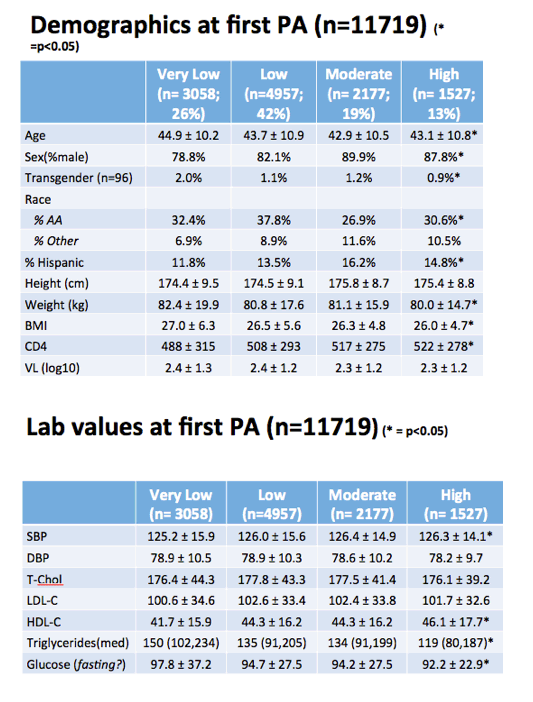
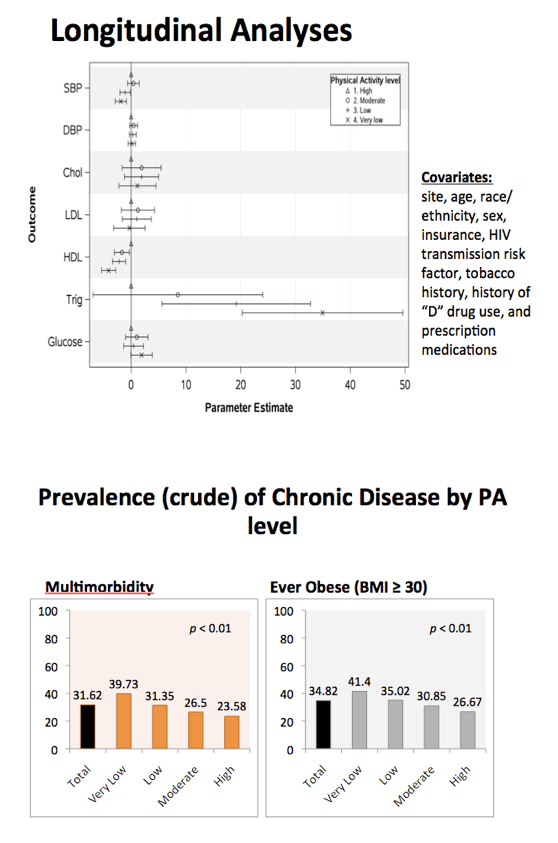
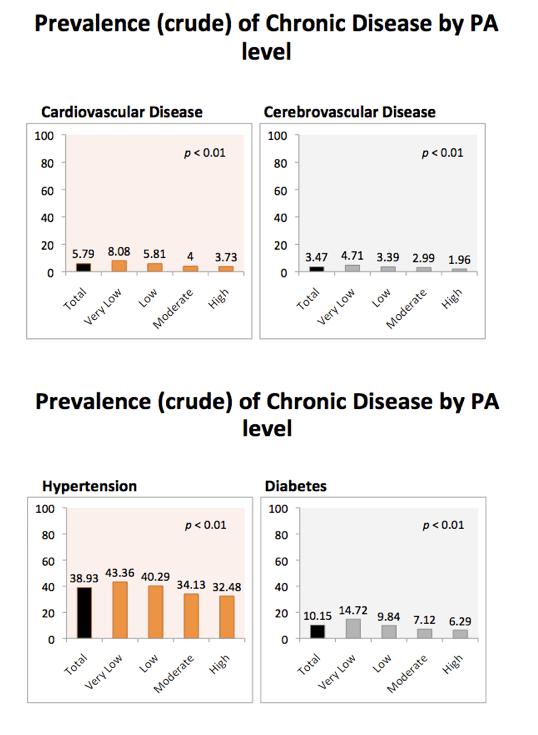
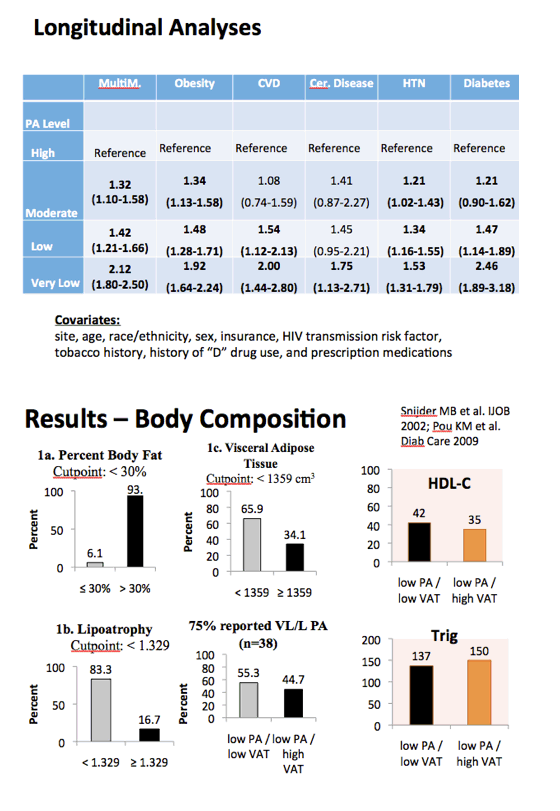
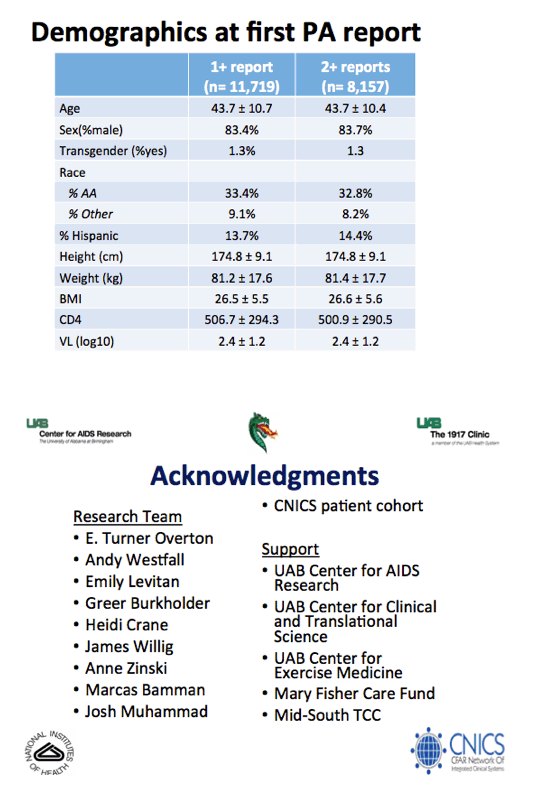
|
| |
|
 |
 |
|
|